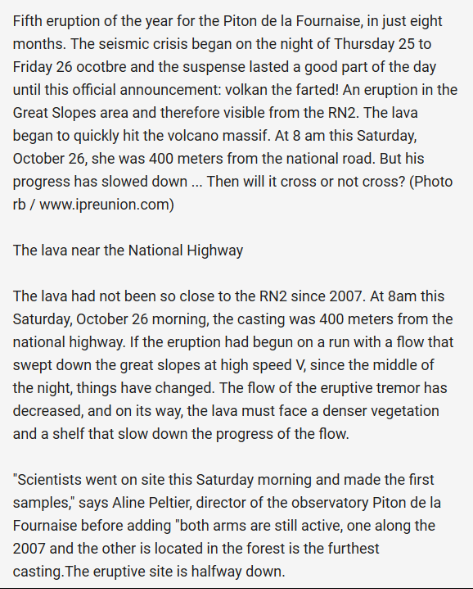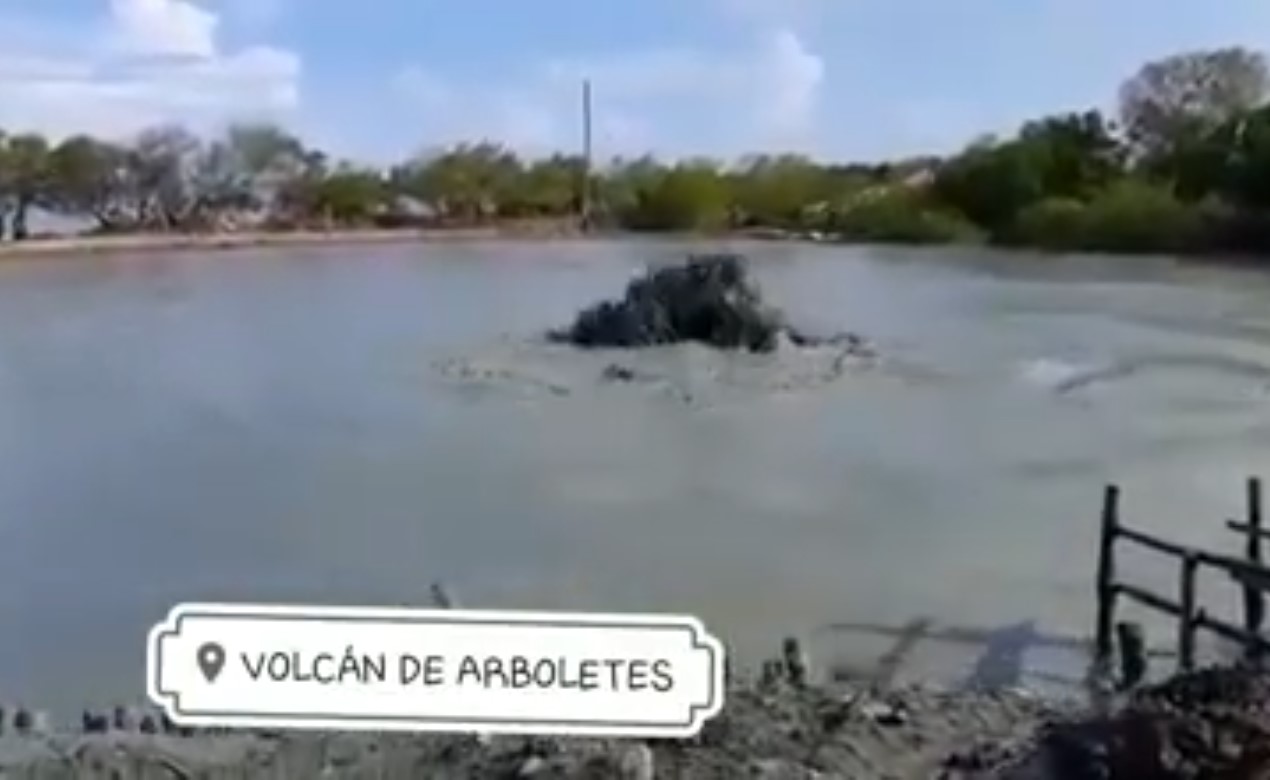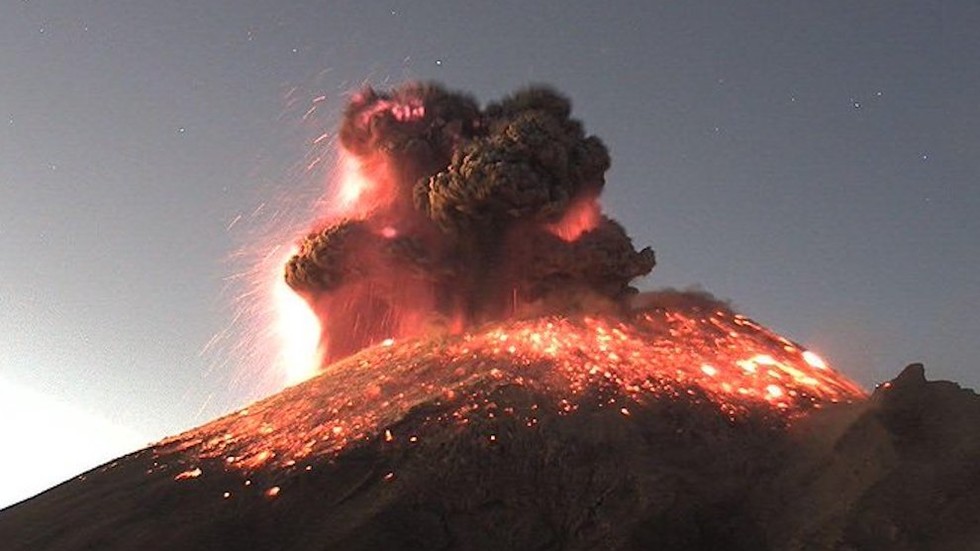An interesting map of status of landslides, volcanos, earthquakes and the like of Indonesia, in Indonesian but, using google traductor you get the idea.







I supposed it is another effect of the same general thing mentioned here, could it be a volcano or something else? as an effect from the sinkhole or they are just interpreting .. Session 1 December 2018
Newly forming underwater volcano discovered near Mayotte, source of intense earthquake swarm
Following the visit of the Minister of Overseas France, the Director of the Bureau des Recherches Géologiques et Minières (BRGM), Frédéric Tronel and a geographer teacher from the CUFR, Casimir Mahadali, have joined forces to give lectures to enable the population of Mayotte to better understand the seismo-volcanic phenomenon that has affected the department since May 2018.
https://watchers.news/2019/12/04/submarine-volcano-near-mayotte-shows-continuous-activity-186-localized-tremors-recorded-in-two-weeks/ said:Submarine volcano near Mayotte shows continuous activity, 186 localized tremors recorded in two weeks

Mayotte: Soil movements recorded on Mayotte GPS stations during the last 3 months from 1-09-2019 to 30-11-2019. The horizontal displacements are represented in vectorial form and the vertical displacements are indicated by the numerical values in color. Image credit: REVOSIMA
REVOSIMA's update on November 30, 2019, showed the continuous seismo-volcanic activity at a newly-forming submarine volcano near Mayotte island from October 16 to 30, including 186 localized earthquakes and an average of 12 tremors per day-- one of which was M3 or greater, with a magnitude of 3.8.
The fissure has been causing crisis ever since earthquake swarms were felt in May 2018. The source was confirmed to be a new underwater volcano in May 2019. On November 21, 2019, it was discovered that the incessant eruptions may contaminate Petite Terre's Lake Dziani.
Over a period of 11 months from July 2018-- the start of surface deformations in Mayotte-- to June 2019, the eruptive lava flow is around 150 to 200 cubic meters per second.
Since the volcanic edifice was discovered, three new remote exit points have been discerned that have produced the following: about 0.2 km3 (0.05 mi3) of lava in 28 days from May to June 2018 for an average minimum flow of about 83 m3 per second (2 930 ft3) in the south; about 0.3 km3 (0.07 mi3) of lava in 44 days between June to July 2019 for an average minimum flow of 79 m3 (2 790 ft3) per second in the west; and about 0.08 km3 (0.02 mi3) of lava in 20 days between July and August 2019 for an average minimum flow of about 44 m3 (1 553 ft3) per second in the north.
The eruptive flows remain high, and the volumes and flows, particularly at the start of the crisis, are unusual. Given the unpredictability, they are generally the highest observed on an effusive volcano since the 1783 Laki explosion in Iceland, whose average eruptive flow had been calculated approximately 694 m3 (24 500 ft3) per second over 245 days of the eruption.
The vectors of horizontal displacements since August 2019 point more towards the north. This resulted in a relative displacement of the simple isotropic pressure source, about 20 to 25 km (12 to 15 miles) more to the northwest, compared to the start of the year. Experts have then formulated several hypotheses.
For the past three months, the best single model that can be responsible for these displacements would be a source of localized deflation between 26 and 73 km (16 and 45 miles) east of Mayotte, and a depth between 45 and 75 km (28 and 47 miles) at 95% probability.
The flows associated with the best models over the last 15 days would be between -30 to -80 cubic meters per second.

Image credit: BRGM
"Note that in the case of a source in deflation, the evolutions of [the] position of the source towards more superficial depths do not translate a source migration but could be linked to the effect of the closure of a conduit, being gradually from the bottom up," according to the bulletin.
"More complex models, under evaluation, suggest that several sources of pressure (in deflation and inflation), geometry and variable volume, located at different depths, could also explain the deformations observed over different periods of time."
The dominant source, nevertheless, remains a source of deflation and such confirm that transfers of magmatic fluids are still ongoing in-depth and they seem to circulate between 20 to 60 km (12 to 37 miles) deep.
...
It appears more people died than first expected:

List of volcanic eruptions by death toll - Wikipedia does not correspond completely with the Spanish version. From the Enlglish the tabel shows there has been more instances of loss of life in the last decade compared to the previous decade.Officials previously confirmed five people had died in the blast, however the number will now rise to around 50 to include those who were still on the island when it erupted.
And the following diagrammes that shows the trend since 1900 but without the more than 600 lost lives in 2018 and 2019.
Fig. 1 The distribution of Holocene volcanoes and those with fatal incidents recorded since 1500 AD
Strong Degassing at Arboletes Mud Volcano in Colombia
By
Strange Sounds
On December 19, 2019, unusual activity was recorded at Arboletes mud volcano in Colombia.
Some powerful degassing occurred in the middle of the crater sending bubbles of gas to the surface.
I don’t know if such powerful bubbling is only a sign of an imminent eruption of it is an explosion itself:
In any cases, I wouldn’t like living in one of those ‘houses’ in the vicinity of that Colombian mud volcano.
According to experts, this phenomenon is normal and occurs once a month, or every two to three months – they actually don’t know.
The mud volcano is located in the Santa Fe de la Plata corregimiento and has had eruptions in 2006 and 2010.
The volcano forms a dome of 600 meters in diameter for a height of 8-10 meters, with two summit mouths, with respective dimensions of 50-60 meters and 3 meters in diameter. It’s a very well-known tourist destination for the medicinal benefits of its mud, which allows people to float and swim on the surface. Continue reading Strange Sounds or visit Steve Quayle.

Strong degassing at Arboletes mud volcano in Colombia video - Strange Sounds
Strong degassing has been witnessed by locals at Arboletes mud volcano in Colombia with giant bubbles exploding at the surface of the mud.strangesounds.org
Strange sounds is reporting that there's been "strong" activity at Arboletes mud volcano in Colombia. News reports are provided but I don't speak Spanish, so i can't undersand from the footage whether this is unusual activity or not. Considering they are reporting on it, i presume it is? Then again, they also note that this "phenomenon occurs once a month" or so, but that they also don't really know how common it is...Video in the article below:

Again?... did not even knew when authorities decrease to level 1(??)Mexican authorities issued a ‘level 2’ yellow alert.
https://watchers.news/2020/01/09/strong-explosion-at-popocatepetl-volcano-january-9-2020/ said:...
Although CENAPRED initially reported ash cloud to 3 km (9 800 feet), according to data provided by the Washington VAAC, it rose to 11.3 km (37 000 feet) a.s.l. by 13:46 UTC, drifting SE and stretching 140 km (86 miles) from the summit.
The initial volcanic ash cloud dissipated by 18:41 UTC and was no longer visible in satellite imagery. Second volcanic ash continued moving NNE at 18 km/h (11 mph) at a height of 8.2 km (27 000 feet) a.s.l., the Washington VAAC reported.
...
https://watchers.news/2020/01/02/extinct-volcanoes-are-coming-back-to-life/ said:Extinct volcanoes are coming back to life
I have been saying for years that global volcanic activity is on the rise and it's now obvious that volcanoes are erupting at a faster pace, not only around the ring of fire but also around the entire globe. Even dormant and extinct volcanoes are becoming active again.
An extinct volcano by definition is a dead volcano, which has not erupted in the last 10 000 years and is not expected to ever erupt again. In other words, an extinct volcano implies that there is no magmatic, seismic or degassing activity going on at the volcano and that it's not expected to erupt again in a comparable time scale of the future.
More importantly, unrest is growing right now among some of the world's Super-volcanoes like Laguna del Maule in Chile and Italy's Campi Flerei -- under the city of Naples. Since 2005, Campi Flegrei has been undergoing what volcanologists call an uplift. Campi Flegrei showing signs of reawakening, Italy6
- A volcano in Russia may be active again and scientists are worried that it could have "catastrophic" consequences1
- Iceland fears dormant volcano may be waking up2
- Previously extinct volcano raised to eruption warning level in Colombia: eruption would be first in recorded history3
- Dormant volcanoes from around the world are coming to life for the first time in 160,000 years4
- Fourth dormant volcano shows earthquake on the West Coast — Mammoth Mountain California5
The Campi Flegrei may be nearing a critical pressure point necessary to drive an eruption for the first time in 500 years, according to scientists. The pace of ground deformation and low-level seismic activity has recently increased and they are similar to two other active volcanoes – Rabaul in Papua New Guinea and Sierra Negra in the Galapagos – 'both showed an acceleration in ground deformation before eruption with a pattern similar to that observed at Campi Flegrei,' said one Italian geophysicist. Enormous Volcano is rumbling below Naples - Scientists alert7
Also, the second biggest land Super-volcano, Toba in Indonesia is showing signs of a possible eruption. "Residents of the villages of Sitoluama in North Sumatra district are in a state of panic as the ground beneath their homes is becoming hot and emitting steam that smells like sulfur and gas."8 The other Sumatran volcano that seems to be waking up after 170 years of quiet is Seulawah Agam. Alert level raised at another Indonesian volcano: Seulawah Agam.9 "The other Indonesian volcano which is very active at the present time is Sinabung. Prior to 2010, Mount Sinabung had been dormant for about 400 years.
"This volcano is located in the Karo plateau of Karo Regency, North Sumatra, 40 km (25 miles) from Lake Toba supervolcano. Many old lava flows are on its flanks and the last known eruption, before recent times, occurred in the year 1600. Solfataric activities (cracks where steam, gas, and lava are emitted) were last observed at the summit in 1912; recent documented events include an eruption in the early hours of August 29, 2010, and eruptions in September and November 2013, January, February and October 2014. A pyroclastic flow in May 2016 killed 7 people. On June 2, 2015, the alert was again increased, and as of June 26, 2015 at least 10 000 people have been evacuated"
Activity at Indonesian Mount Sinabung remains high, January 17, 2017.10 The other super-volcanoes that show signs of unrest are those in Iceland, Greece, Bolivia and the biggest one of them all the Yellowstone Super-volcano in the US. All of these super-volcanoes systems are now exhibiting clear signs of inflation, an early indication that pressure is building in these volcanic systems.
On the other hand, the Nyamuragira volcano (DR Congo) is becoming active again after the 2002 eruption that killed 147 people and forced 400 000 people to flee the nearby city of Goma. One of Africa's most active volcanoes is showing new signs of life.11 Nyamuragira volcano (DR Congo): Strong thermal signal from the summit area, January 15, 2017.12 See the following link for more active volcanoes worldwide.
These geological activities have exposed entirely the truths regarding the current mainstream view about climate change. But, the mass media is not giving up. No matter what scientific data you provide about the real cause, the final decision is in the hands of people like Al Gore. In fact, I saw one peer-reviewed paper that claims the increase of volcanic eruption is caused by the emission of greenhouse gases. How much more stupid can it get?13
The first question anyone would ask is why there is an increase in volcanic activity? And secondly, why are even dormant volcanoes becoming active? And how can a dead volcano come back to life?
If you are going to ask these questions to any mainstream geologist or geophysicist, you are not going to get real scientific answers. Because there is no way these questions can be explained with current theories. This is the reason why the mainstream has averted the issue altogether. But, of course, all geophysicists, especially volcanologists know very well that there is a massive increase in volcanic activities. This fact is overwhelmingly clear from short and long term statistics.
The number of volcanoes that are erupting right now is higher than the average number of volcanic eruptions in the 20th century. However, it is a well-known fact and everyone agrees with it, that when volcanoes erupt they release internal heat and pressure. And therefore, if the Earth has been around for only 4 million years, not 4 billion years, then according to a calculation based on elementary physics the core of the Earth should be a dead-cold, by now not hotter than the surface of the Sun.
So, how can the Earth's core maintain such temperature, taking into consideration the size of the Earth, the number of land and submarine volcanoes and how many times they have erupted since Earth's creation? Without revising the fundamental laws of physics, these questions and other basic questions about our own star and planet cannot be understood.
Can current physics explain why the Sun and the Earth have magnetic fields in the first place? Or the most important question, the origin of magnetic fields in the Universe as a whole? And why these magnetic fields change from time to time? Why Earth takes a very long time to change its magnetic field compared to the Sun? And why there are times when so many volcanoes erupt at the same time?
Nonetheless, revising the fundamental laws of physics under the current political-economic system is completely out of the question. Fake science is a very huge business, and it has been for decades. This conduct is a clear sign that the moral decay of our society has reached its lowest level.
